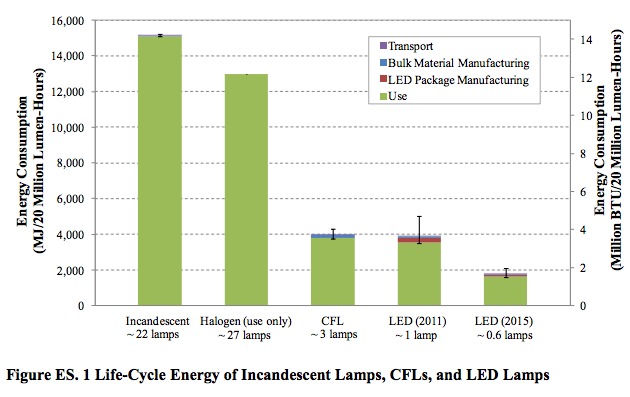Send your question to Umbra!
Q. Dear Umbra,
My little brother, a pretty staunch environmentalist, just graduated from college and spent the last year of his service-learning job working for the college’s electricity crew. He adamantly insists that while LEDs indisputably save a lot of energy in their usage, the components and energy that go into constructing the LED and its circuit board outweigh the savings — just like the construction of a new electric car uses more resources and energy than it would save over driving a used car. I haven’t been able to find too much on this aspect anywhere and was wondering if you might be able to weigh in.
Adam T.
Arlington, Va.

Giulia BartraBut can incandescent lamps do this?
A. Dearest Adam,
How lovely to come from a family in which the adamant opinions of younger siblings are valued, mulled, and questioned. Kudos to your parents for raising such thoughtful young men. Unless, of course, you’re writing so you can wave my answer in your brother’s face — a grown-up version of the wedgie.
I get questions along these lines quite a lot, without the dramatic sibling interplay. (Note to letter writers: Odds of being published increase 62 percent when dramatic sibling interplay is involved.) When I wrote about cars this spring, I received several “yes, but” letters. Don’t the energy and resources required to manufacture greener products overshadow the savings we get from using them?
The answer is almost always no. The manufacture and transport of these items does not outweigh the energy savings from their usage over time.
“Manufacturing LEDs does require more energy than manufacturing incandescent lamps,” says Jeremy Snyder of the Lighting Research Center at Rensselaer Polytechnic Institute. “However, when the total energy is considered, including the energy used to produce light, LED lamps end up using only about a quarter of the energy of incandescent lamps.”
You might point your brother to a report [PDF] produced by the U.S. Department of Energy that compares incandescent bulbs, halogen bulbs, compact fluorescents (CFLs), and light-emitting diodes (LEDs). Usage accounts for 90 percent of the energy impact of a lightbulb, DOE tells us. In fact, on page 3, you will find a compelling graph comparing the bulbs. Actually, I like this graph so much I am going to save you the trouble and reproduce it right here:
Let’s hear it for bar graphs!
I should note that the phrase “LED Package Manufacturing” does not mean the boxes the bulbs come in. Rather, it refers to a stage that involves, according to DOE, “mounting the LED chip in housing, providing electrical connections, coating with phosphor (for pc-LED packages), and applying the encapsulant and optics.” All of which makes LEDs more complicated to build than incandescent bulbs — but the point is, once the LEDs are built, their efficiency makes up for the extra energy that went into making them. On top of that, improvements in LED manufacturing should cut the impacts dramatically over the next few years. (For more on how the various bulbs look, what they cost, and so forth, visit RPI’s Lighting Patterns for Homes site.)
Now before you get all smug, your brother and his pals on the electrical crew do have a point about the components in LED circuit boards and housing, which include lead, copper, and aluminum. They are resource-intensive to produce and technically make some LEDs qualify as hazardous waste. But new technologies are emerging all the time. We should not dismiss LEDs on this count. They still have less impact than the old standbys.
By the way, in regards to your comment about electric cars, the same general principle has been found to be true of automobiles. As one Swiss study [PDF] politely put it, “the impact of operation dominates in transport service.” In other words, it’s the driving that matters most. This is especially true where harmful emissions are concerned. Says the Union of Concerned Scientists, “global warming emissions generated while the vehicle is being driven are notably lower for an efficient hybrid than a conventional vehicle, far outweighing the difference in manufacturing-related emissions.”
Adam, your brother had the story half right. It is often more resource-intensive to manufacture new, higher-tech products. And if you have a perfectly good car or bulb, sure, you can choose to keep using it until it is no longer usable. But when replacement time comes, the new products are worth it.
You have my permission to commence word-wedgies now.
Siblingly,
Umbra




